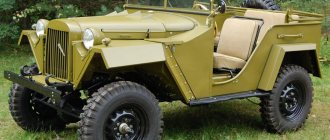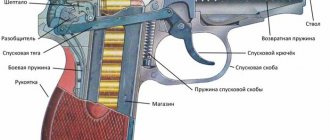Prototypes
And even though GAZ froze it, it’s still worth looking at, albeit experimental, samples of the GAZ-3106. Serial production of an all-terrain vehicle, and this is how the development was presented, was supposed to start back in 2000. In the same year, GAZ was sold, a natural continuation of this purchase was a major reorganization. Many promising models were either frozen or cancelled, but prototypes of this car were developed until 2006.
So, what can we say about the GAZ-3106, which was never put into mass production? According to the plant's specifications, a 7-seater car was planned on a slightly shortened frame from the "Ataman" (more about it below) and with an original body, which was supposed to be installed on vibration-isolating cushions. According to the developers, such a solution should not only provide good vibration isolation, but also solve the noise problem.
The equipment of the car had to satisfy the tastes of the average consumer. Despite the positioning of the car in the off-road class, the specifications included airbags, electric drive for mirrors and windows, and ABS control. Of course, as for any SUV, a 5-speed manual was planned, but however, an automatic transmission was installed for additional money. Air conditioners could also be ordered as an additional option.
Inside, it was planned to repeat the interior of the tenth model, but for the convenience of the end user, the mechanics of adjusting the seats were redesigned. Just like many five-door versions, the rear seat could be folded in sections, which made it possible to carry a long load, and at the same time seat several passengers.
Luxury SUV GAZ “Ataman 2”, which could compete with Toyota Land Cruiser and Lexus
Since Soviet times, AvtoVAZ has earned a reputation as a plant that produces truly people's cars. On the one hand, this helped the manufacturer earn people's love and recognition, but on the other hand, it meant that AvtoVAZ was always not up to technical delights and advanced design solutions, because the main thing was always to make an affordable car. Another thing is the GAZ enterprise, which until the early 2000s tried to keep domestic officials and deputies driving Russian premium cars.
GAZ-3106 "Ataman-2" 2000
GAZ designers did not deny themselves anything. For a long time they tried to offer a prestigious car that could compete (at least in their home market) with products from the popular brands Audi, BMW and Mercedes. One of these attempts to “answer” was the GAZ 3106 “Ataman 2”. Not much, not less, the car was positioned as a competitor to Lexus and Toyota Land Cruiser. And I must admit, the Russian handsome man almost succeeded.
GAZ-3106 "Ataman-2" 2000
Experienced motorists about it are similar to the German Porsche Cayenne. This is true, only the Russian luxury SUV was released in 2000, and the German one only in 2002. As you might guess from the name, the project of the Russian prestigious SUV was a direct development of the Ataman project of 1996. It should be noted that the first generation of SUVs turned out to be completely strange. This was especially true for appearance. The new product turned out to be very smooth and pleasing to the eye.
GAZ-3106 "Ataman-2" 2006
Despite the external differences, a significant part of the filling migrated to Ataman 2 from the first generation of the SUV. However, GAZ designers took into account the mistakes made earlier. This concerned both the filling and the design of the car. The steering wheel, brakes and suspension remain virtually unchanged. Some of the details migrated to 2 from Sobol. The only thing that was made completely from scratch was the transfer case. We put a Russian SUV on a spar frame. The cabin could accommodate up to 7 people. The car was driven by a 141-horsepower diesel engine.
GAZ-3106 “Ataman” 2004/2005
What prevented the updated Ataman from entering the market and its further promotion? But only one thing prevented it - the decision of the plant management, which at the beginning of the new century for some reason decided that the project was too bold and “not economically justified.” Then the directors were simply afraid that there would simply be no demand for a premium domestic SUV. All this did not stop the designers from creating the third generation of the car by 2004, however, despite the improved hardware and design, the project suffered a similar fate.
GAZ-3106 “Ataman” 2006
Stories of the production of SUVs based on GAZ are not so rare, so we talked about the serial Kazakh SUV LAF 4101, which combined GAZ-3307, GAZ-66 and Volga .
The appearance of the second generation of the GAZ-3106 car
Despite the excellent start of the GAZ-3106 project, it had to be curtailed in 2001, since the plant was unable to allocate a sufficient amount of money to finalize the project and put it on the production line. But in 2004, looking at how sharply sales of domestic SUVs UAZ and Chevrolet Niva had risen, the management of the Gorky Automobile Plant decided to revive their project.
GAZ-3106 2004 was distinguished by the following design features:
- The car received a spar frame, which is a sign of a real SUV, although the appearance of the GAZ-3106 makes one think of crossovers;
- Five-door body;
- Front and rear independent suspension;
- Four-wheel drive;
- Lockable center differential;
- Two-stage transfer case.
The ZMZ-405, which developed 147 l/s, was installed as the base engine for the SUV. The choice of engine was not very successful. Although it has proven itself well on passenger Volgas, its capabilities were clearly not enough for a heavy frame SUV. In addition, the engine, forced to operate at high speeds, was prone to overheating.
https://youtube.com/watch?v=kgZm0rgh-xA
In 2005, a luxury version of the GAZ-3106 was presented at an international exhibition. The new modification, which received the prefix “VIP”, had the following features:
- Full power accessories;
- Leather interior;
- Separate rear row seats with electrical adjustments;
- Wooden elements of the dashboard;
- The new ZMZ-4052 engine, which was a serious modification of the standard ZMZ-405 engine. This turbocharged long-stroke engine was capable of developing 205 hp.
Unfortunately, the GAZ-3106 modification of 2004 also did not make it into mass production.
The history of the appearance of the first SUV GAZ-3106
The first GAZ-3106 “Ataman-2” was assembled in 1999. This SUV received many components from the previous GAZ development, which had the GAZ-3108 “Ataman” index:
- Shortened chassis from "Ataman";
- Bridges;
- Steering;
- Front suspension;
- Brake system and wheels.
Some design solutions were borrowed from Sobol. Looking at the success of UAZ SUVs and the complaints of their owners about the overly archaic appearance of SUVs, the management of the Gorky Automobile Plant decided to rely on the appearance, which the Ataman of 1996 was so lacking.
The new passenger SUV from GAZ received full differential locking, since the design of the rear axle made it possible to do this. Due to this, it was possible to achieve excellent traction on all four wheels. Having analyzed the situation with UAZs, which in those years could not be called comfortable cars for driving around the city, Gorky designers decided to exclude intermediate shafts from the car’s design. This ensured silence in the cabin. Since cross-country ability decreased as a result, it was decided to make the front and rear suspension dependent.
Project development history
The family has a rich history. After the release of the next update, it was planned to launch mass production, but this never happened.
First generation (2000)
The GAZ-3106 Ataman 2 is based on a shortened chassis from the Ataman model of 1996. The axles, front suspension, steering, brake system and wheels are completely preserved. Some elements were taken from Sobol and unified. The design of the rigid rear axle with spring suspension allows the installation of a differential lock. This provides sufficient traction to all wheels. Intermediate shafts are eliminated from the design to ensure a quiet interior. To improve cross-country ability, the rear and front suspensions are made dependent.
GAZ-3106 is an SUV with all-wheel drive on a spar frame. Capacity - 7 people. For this purpose, three rows of seats are provided. It was planned to assemble technical components from parts from domestic and foreign companies (Iveco and Toyota). The prototype received a GAZ-561 power unit, which has 5 cylinders and develops 141 horsepower.
For passenger comfort, the seats are equipped with headrests. For safety, each seat has a retractable seat belt. The tank is installed inside the frame, this has a positive effect on passive safety. Also, thanks to this arrangement, it was possible to lower the floor in the cabin, but it did not turn out to be perfectly flat.
The rear suspension was deprived of the Watt mechanism, it was replaced by a Panhard mechanism. This is caused by the large number of hinges and the complexity of assembly. The simplified mechanism provides good stability on the road. The suspension is tuned for use on public roads, but this does not reduce the off-road ability.
Second generation (2004)
The development of the SUV was stopped in 2001 due to lack of funding. In 2004, looking at the successes of the Chevy Niva and Patriot, engineers proposed a new SUV with the old index. The retail price was planned to be set at around 10 thousand dollars. The project leaders abandoned the name “Ataman 2” so that consumers would not associate it with old developments.
The new car was built according to the classic SUV design. It had a spar frame, a five-door body, dependent suspension, all-wheel drive, a two-speed transfer case and a locking center differential. A ZMZ-405 power unit was placed under the hood, which develops 147 horsepower. The second generation GAZ-3106 met all modern requirements: the steering column was customizable in many ways, the design included power steering, and airbags and ABS were added for safety.
In 2005, at the international exhibition, the Gorky Automobile Plant presented two versions of 3106: basic and VIP. The second received leather interior trim and full power accessories. The back row has separate seats, each of which is electrically adjustable. The rear seats fold in a 1:2 ratio. The interior design is complemented by wooden elements on the dashboard.
In addition to external changes, technical characteristics have changed. The base engine was replaced with a 16-cylinder with a volume of 2.5 liters. It developed up to 204 horsepower. In the technical documentation, the mark of 170 km/h is indicated as the maximum speed. The standard engine developed up to 147 horsepower.
Third generation (2005)
The final development was an SUV, which received the index 31061. It was presented to the public in 2005. The wheelbase has become longer by 40 millimeters, the rear doors have been enlarged to increase comfort when boarding and disembarking passengers. Among the external differences, the chrome radiator grille, new design of headlights and bumper immediately catches the eye.
The salon is different from 3106 VIP. It became simpler, but retained the electric drive on the windows and mirrors. The back row folds in a 1:2 ratio. The trunk opens like a door and a spare tire is attached to it. The GAZ-5602 power unit has a volume of 2.13 liters and develops up to 120 horsepower.
The long-stroke dependent suspension is made of a spring type and is complemented by forged levers. It is based on the shortened Ataman base. The suspension is highly durable and allows you to overcome off-road conditions at high speed.
The planetary transfer case has two stages and operates via a Morse chain. The transfer case is supplemented with a lockable cylindrical center differential (made on the basis of the Volga gearbox; a limited slip differential can be installed on the rear axle).
Burlak, Atamans and Kombat: why GAZ’s bold developments never became mass-produced
Volga GAZ-3105 , which was supposed to replace both the “thirty-first” and the Chaika GAZ-14 fell victim to circumstances . Unfortunately, it didn't work out. But in the nineties, Nizhny Novgorod did not sit idly by, but were engaged in new developments that would help the plant survive and stay afloat in difficult times. Gazelle in the form of the GAZ-3302 truck and GAZ-3221 minibus found its embodiment in serial production, quickly becoming a real bestseller. But in addition to the ubiquitous gazelles, in those years GAZ created several more very interesting SUVs and pickups, which, however, were not destined to reach the production line.
Burlak
The urgent need for light-duty trucks in the USSR was felt even before the Soviet Union ceased to exist, because during the transition to the notorious “self-financing”, the operation of heavy-duty vehicles for transporting small quantities and light loads turned out to be not very practical. And the “cooperators” needed such equipment and, in the absence of other options, actively purchased Izhevsk “heels” and Yerevan ErAZ-762 vans .
That is why GAZ decided to create a “commercial” line the Volga GAZ-21029 After all, homemade Volga pickup trucks based on decommissioned cars have been produced by many auto repair companies since the seventies. Practice has shown that the Volga platform is quite suitable for such use - especially if the alterations are carried out at a higher technical level than was done when handicraft “cutting” the body to turn it into a pickup truck. If in the first version at GAZ they first simply removed the “extra” body parts, then a year later the designers extended the wheelbase to 3,100 mm, and also integrated a small frame into the rear of the body, on which they installed a cargo platform.
The Volga pickup truck based on the M-21 or GAZ-24 is a semi-handicraft product of numerous auto repair enterprises, which had no relation to the serial production of GAZ
The basic GAZ-2304 pickup truck with an open platform looked good
In Nizhny Novgorod, they planned to produce “Burlak” (namely, this is the name with historical and professional connotations that the car received) in several modifications - a cargo pickup truck with an open body, as well as all-metal vans (including an eight-seater passenger version and an isothermal body) and even a “dump truck”! The plant did not forget about doctors and security forces - it was assumed that in addition to ordinary cars, special vehicles for the police and ambulance would be produced.
Between the “heel” and the Gazelle: pickups and vans based on the Volga were supposed to fill the “empty” niche in terms of carrying capacity. Did not work out
“Burlak on the Volga” is the very case when the name of the car ideally reflects its intended purpose and conveys the essence of the modification
A variety of power plants were envisaged - both gasoline and diesel, which would significantly affect the selling price of a particular instance.
It’s interesting that to increase the Burlak’s load-carrying capacity, trailers were also developed - the regular cargo GAZ-8156 and the “transformable dacha” GAZ-8160.
The designers intended to increase the load capacity of the Burlak using a trailer
The short-wheelbase prototype of the Burlak on the Volga appeared at MIMS-93, but prototypes of the GAZ-2304 Burlak with a wheelbase increased by 300 mm were tested in 1994, after which the new product was officially presented at the Nizhny Novgorod Fair and the Moscow Motor Show.
A new family of pickups and vans was supposed to hit the production line in 1995, but at that time the plant did not have the production and financial capacity for this and was completely focused on the Gazelle, with which pickups and vans based on the Volga would compete with each other in one way or another. As time has shown, the bet on the “lorry” was correct - Gazelle, as they say, helped not only small businesses in Russia, but also the car plant itself.
Ataman and Ataman-II
When the demand for medium-tonnage trucks noticeably decreased, it was Burlak that decided to compensate for the conveyor load. However, not all GAZ assembly lines were suitable for this, because on many of them the technological equipment required the car to have a frame on which the cab, platform and units were mounted. That is why the “semi-supporting” GAZ-2304 based on a passenger car could not be assembled here. To ensure that the “cargo” assembly line and the new welding and painting equipment for the production of cargo cabins of the 3307 model did not stand idle, the factory workers decided to create an unusual vehicle with a frame structure, which in terms of load capacity (800-1000 kg) would be slightly inferior to the Gazelle, but at the same time would use a cabin from regular lawn!
Russian motorists learned about the unusual GAZ prototype from the pages of the August 1995 issue of Za Rulem magazine.
It was assumed that the basic version of the GAZ-2307 would be produced in the form of a chassis, on which it would be possible to install both a “pickup” body and conventional flatbed and dump platforms, a tank, a “shift truck” and so on.
By the beginning of 1995, the first prototype was created, which was a bizarre symbiosis of GAZ-31029 units (front suspension and rear axle, power unit, wheels and tires) with the frame and cabin elements from the GAZ-3307. Despite the original cargo platform and the new front tail, stylistically linked to the “lowered” platform of the Volga, the prototype did not turn out to be very attractive - the proportions turned out to be too comical. The large windshield, high roof and standard “lawn” doors did not go well with the “slick” front part and small wheels, as if taken from a toy car.
1 / 4
2 / 4
3 / 4
4 / 4
“Cheburashka” ZIL-4305 is an in-plant Zilov analogue of the “Ataman”, built on the units of a representative limousine using a standard cargo compartment
ZIL also tried to use part of the “large” cabin on small trucks - this is how the “Bychok” appeared
But the consumer had already tasted the well-proportioned GAZelle, so such mutants were not very interesting to him.
That is why the car did not find much support from potential buyers, although it was repeatedly demonstrated at various exhibitions - from the Nizhny Novgorod "Avtotechservice-95" in April and ending with the Moscow MIMS-1995 auto show, where, in addition to the "lowered" rear-wheel drive, a much more harmonious version with all driving wheels.
1 / 3
2 / 3
3 / 3
After all, the GAZ-2307 was only the first-born of a new family of SUVs called “Ataman”. The all-wheel drive GAZ-2308, while externally similar to its predecessor, was distinguished by its original frame design and a new front axle with spring suspension. By noticeably increasing the ground clearance and installing large wheels, the designers visually balanced the car, which, thanks to its high seating position, looked much more harmonious even taking into account the “lobed” cabin. In addition to the Ataman with permanent all-wheel drive, Nizhny also created the experimental “Ataman” GAZ-2309 with rear drive wheels. Well, under the hood appeared a licensed Steyr turbodiesel, which was also equipped with certain batches of gazelles.
GAZ-2308 with ZMZ-4063.10 engine, manufactured at GAZ in 1998
In terms of ergonomics, Ataman is not far from the “cabin donor” - the GAZ-3307 truck, but the interior decoration has become much more presentable
Tests have shown that "Ataman" has excellent maneuverability. The developers did not stop at the cargo version, but also created a large station wagon GAZ-230810 called “Ataman-Ermak”. Theoretically, such cars could well find their buyer in the vast expanses of Russia - for example, if the customer were both state and commercial enterprises that required a spacious and durable domestically produced SUV. Forestry, oil industry, farmers, geologists, rescuers - this is not a complete list of potential buyers of such equipment, for which GAZ has developed almost two dozen body and transmission variations. Moskovskaya even created a cash-in-transit armored car based on the GAZ-2308 with an all-welded armored body structure.
1 / 5
2 / 5
3 / 5
4 / 5
5 / 5
Alas, both the standard “Ataman” and the more passenger “Ermak” turned out to be too tough for the plant itself, which at that time was not only developing a commercial line in the form of Gazelles and Sable, but also once again modernized the old Volga, mastering its new iteration under the index 3110 . Therefore, the circulation of the first Atamans was limited to several dozen assembled prototypes.
In 1999, factory workers surprised the Russian public with a new prototype under the designation GAZ-3106, which also received the code name “Ataman-II”. That year, the new product was a little late to arrive at the Russian Motor Show on time for a good reason - its fiberglass concept body was manufactured according to the order and mathematical models of GAZ... in the USA, at Venture Industries. “Hanging up” for unknown reasons at American customs, Ataman-II got to MIMS only the following year, 2000, first appearing on the pages of the magazine “Behind the Wheel.”
In 1999, Ataman-II did not have time to get to the Moscow Motor Show, so in the “Zarulevsky” material about this event there were drawings instead of photographs of the prototype
GAZ-3106 became the real star of the October 1999 issue of “Behind the Wheel”, but the new product itself became an object of ridicule due to its controversial design
The appearance of the prototype (essentially a running model) of the second Ataman was the subject of heated debate and fierce criticism from both professional journalists and ordinary Russian motorists.
The designers decided to take a risky step and actively exploited the theme of “nostalgic motifs” in the appearance of a rather large crossover, as if referring the viewer to the first Volga GAZ-M21 . It turned out, to put it mildly, to be an acquired taste: a somewhat cross-eyed and generously chromed car with plump sides evoked associations not so much with the “twenty-one” and the “goat”, but with a sick hamster. However, anyone can offend an artist, but there were no obvious fans of the appearance of “Ataman-II” with a similar embodiment of retro themes.
1 / 3
2 / 3
3 / 3
The prototype had not only the exterior, but also the interior worked out
The GAZ-3106 shared with the first Ataman a chassis shortened by 280 mm. The car was supposed to have a whole line of engines: four- and five-cylinder “Steyr” diesels, as well as gasoline “fours” with a volume of 2.3-2.7 liters, although the developers saw even V6 and V8 engines with a displacement of 3 to 5 under the hood of the Ataman .5 liters! Dreams Dreams…
At the time of the demonstration of the running model in 1999, questions remained open about some components and assemblies - for example, about the all-wheel drive transmission. However, this Ataman was destined to remain a concept without design documentation and equipment: in 2000, GAZ OJSC was acquired by Oleg Deripaska. After this, a major reorganization began at the plant, and a number of promising developments, including Atamans, were simply closed on the instructions of the management, but... not forever!
In 2003, observing the market success of the Chevrolet Niva and the latest UAZ models, GAZ again returned to the theme of “Ataman” and presented at the August International Motor Show in Moscow a new prototype of a budget SUV, and under the familiar GAZ-3106 index hid a completely different car, which was related with Ataman-II there is only a classic spar frame for an SUV with dependent suspensions. Other “Jeeper” attributes include permanent all-wheel drive, a two-speed transfer case and a locked center differential. As in the case of the first Ataman, the American company Venture was involved in the project. However, at the same time, the appearance of the car became completely different - the not very expressive, but rather harmonious SUV no longer brought back memories of either the “goat” or the first GAZ-3106.
The new version of the GAZ-3106 in the first iteration was featured in the January 2004 issue of “Behind the Wheel”...
...and the prototype of the second experimental series is in the December issue of the same year
The highlight of one of the prototypes was the experimental 2.5-liter 16-valve four-cylinder turbo engine ZMZ-4054, which produced as much as 204 hp, although in the proposed line of power units they were supposed to appear as naturally aspirated gasoline engines with a volume of 2.5-2.7 liters , and diesels.
At the 2004 Moscow Motor Show, a prototype of the new GAZ-3106 of the second experimental series was presented, which was visually distinguished by a different design of the front end with a chrome radiator grille and larger headlights. In addition, after a series of tests of prototypes of the second series, GAZ created a prototype of the third experimental series under the symbol 31061, which was distinguished by elongated rear doors and a wheelbase increased by 40 mm (up to 2,650 mm), due to which the overall length of the car was 4,610 mm. Serial production of SUVs with an estimated cost of about 12-15 thousand dollars was planned for the end of 2006, but then “something once again went wrong.” Despite the fact that the public showed a certain interest in promising developments, already at the end of 2005, GAZ OJSC stopped further work on Project 3106 - and this time for good.
1 / 4
2 / 4
3 / 4
4 / 4
Combat
The “nostalgic” theme of the plant’s early models was heard again in 2000, when a prototype of the GAZ-2169 Kombat SUV was presented at MIMS-2000. This concept became a real “show stopper” at the Moscow Motor Show, causing a storm of emotions and a surge of nostalgia among visitors. The reason was the appearance of the “jeep,” which clearly hinted at a historical relationship with the legendary “goat” GAZ-69. The implementation of retro motifs here also caused different reactions, and also produced somewhat contradictory opinions due to the specific proportions of individual body elements. However, Kombat was not considered a “freak” at first glance, as was the case with the GAZ-3106 located next to him at the stand. That is why the Grand Prix of the 2000 exhibition was awarded to GAZ OJSC, including for the Kombat project.
1 / 3
2 / 3
3 / 3
As in the case of the GAZ-3106, the Kombat was based on a classic frame design
Both Combat and Ataman-II were fully demonstrated to the public at MIMS-2000
In design, the updated Kombat was somewhat reminiscent of the second generation Daewoo Korando - a compact SUV that appeared in 1996, the appearance of which also actively used the theme of nostalgic design with a hint of the Jeep CJ-7, of which the first generation Korando was a licensed copy. By the way, the temporary coincidence of the beginning of the release of the updated Korando and the debut of the first Combat in 2000 gives rise to certain thoughts about what served as the impetus for the Russian development...
1 / 3
2 / 3
3 / 3
In 2001, the first “Kombat” was repainted blue
As in the case of Atamans, which were closed during the reorganization, the plant returned to the Kombat project a few years later - or more precisely, in 2004. The exterior of the car retained the nostalgic stylization of the GAZ-69 GAZ car, but at the same time got rid of the touch of fake-pseudo-Jeeper “costume jewelry.”
In 2004, the second version of the Battalion Combat was released under the symbol 3120, which, while externally similar to the first-born GAZ-2169, was distinguished by the increased dimensions of the new body
Alas, this prototype repeated the fate of the Atamanov, as well as its predecessor, remaining forever in the status of a concept.
Perhaps, two decades later, these developments will seem frankly absurd and even funny to the modern reader. But if you remember that at that time, having survived the collapse of the USSR and the default of 1998, hundreds of Russian enterprises simply closed, you can look at such creativity of GAZ from a different point of view - at least they at least tried to create something new and interesting .
Survey
Which of GAZ's projects do you find most interesting?
Your voice
Total votes:
“Ataman” and “Ataman-2”
Before writing about the characteristics, we note that the GAZ-3106 jeep did not become a “Volga”, like all the cars of the plant. He received the official name "Ataman-2". Moreover, the two in the name is not accidental. “Ataman” was (simply) planned as a light truck, while, having appeared earlier than the famous GAZelles, it had a very unusual design at that time.
The design turned out to be successful, and on its basis a few years later they began to develop the GAZ-3106, or Ataman-2. We can say that the fate of “Ataman” was more successful than that of his child. “Ataman” left the assembly line and went... to Belarus. On the Internet you can find descriptions and reviews of this car, which indicates that it was on sale, albeit in small quantities.
Suspension
We have already mentioned earlier that the design of the “Ataman” was borrowed from the “Volga” and “GAZON”. The manufacturer also decided not to create the chassis from scratch. Thus, many elements were borrowed from the GAZelle cargo truck, which entered the production line in 1994. Thus, the car has a frame supporting structure with permanent all-wheel drive. The rear drive axle was borrowed from the GAZ-3302. The car has a dependent, leaf spring suspension. The steering mechanism is gear type, without hydraulic booster. However, the gear ratio is selected in such a way that it is possible to control the Ataman’s drive wheels without power steering. The fuel tank and brake mechanisms are also borrowed from the GAZelle. Thus, ventilated disc mechanisms are used in the front. There are “drums” at the back. Additionally, the Ataman GAZ-2308 SUV is equipped with a stabilizer bar.
The GAZ-3106 jeep will cost 10 thousand dollars and has already passed tests
Archive NEWSru.com
ALL PHOTOS
The GAZ-3106 jeep will cost 10 thousand dollars and has already passed tests Archive NEWSru.com
Judging by the plant's press releases, the GAZ-3106 will be an SUV in the American tradition - very spacious, with a huge interior and trunk, smooth ride, solid and clumsy Archive NEWSru.com
Judging by the plant's press releases, the GAZ-3106 will be an SUV in the American tradition - very spacious, with a huge interior and trunk, smooth ride, solid and clumsy Archive NEWSru.com
It is possible, however, that a much more peaceful modification will go into production - with square headlights, a modest black radiator grille and moderate stampings on the sidewalls Archive NEWSru.com
GAZ-3106 will be an SUV in the American tradition - very spacious, with a huge interior and trunk, smooth ride, solid and clumsy Archive NEWSru.com
GAZ-3106 will be an SUV in the American tradition - very spacious, with a huge interior and trunk, smooth ride, solid and clumsy Archive NEWSru.com
GAZ-3106 will be an SUV in the American tradition - very spacious, with a huge interior and trunk, smooth ride, solid and clumsy Archive NEWSru.com
The Gorky Automobile Plant is quickly working on the issue of launching mass production of a new development - the GAZ-3106 SUV. Izvestia claims that the jeep has already passed test tests, after which the plant began to say that the model will be a serious competitor to the VAZ Chevrolet-Niva jeep.
The estimated price of the new jeep is set at 10 thousand dollars
.
The owners of the plant plan to finally decide on serial production in a month. And if the management of the Ruspromavto holding, which includes GAZ, decides to put the jeep into production, it will go on sale in 2006. So far, the plant has assembled only two jeeps, one of which is the so-called “hunting version”. It is painted in camouflage color, has more rounded headlights than its classic “brother”: PHOTO 1 PHOTO 2 PHOTO 3 PHOTO 4
Judging by the press releases of the plant, the GAZ-3106 will be an SUV in the American tradition - very spacious, with a huge interior and trunk , with a smooth ride, solid and clumsy: PHOTO 5
PHOTO 6 PHOTO 7
There are several design options - the most brutal was demonstrated at the Moscow Motor Show: with huge headlights, a relief, sparkling radiator grille. It is possible, however, that a much more peaceful modification will go into production - with square headlights, a modest black radiator grille and moderate stampings on the sidewalls: PHOTO 8
PHOTO 9
As for the design, this is an all-wheel drive SUV on a spar frame, the interior of which has three rows of seats can accommodate 7 people. Under the hood of the GAZ-3106 it is planned to install domestic and imported engines produced by Iveco and Toyota. The prototype was equipped with a modernized five-cylinder GAZ-561 diesel engine with a power of 141 hp. With.
The GAZ-3106 is equipped with permanent all-wheel drive; a new transfer case with a multi-row Morse plate chain and a locked center differential has been developed for it.
History of Gorky SUVs
The production of jeeps at the Gorky Automobile Plant began in 1941 with the GAZ-64; in 1943, the plant's lineup was supplemented by the GAZ-67. Exactly ten years later, in 1953, production began of the two-door GAZ-69 and four-door GAZ-69A, nicknamed “goats” for their excessive jumping ability. The last representative of this family was made at GAZ in 1956 - after which the plant concentrated on producing passenger cars for the party nomenklatura and the wealthiest Soviet citizens.
While there was good demand for the Volga, the plant management did not even think about new production of jeeps, and only in recent years did GAZ begin to present its off-road developments to the public at almost all Moscow auto shows. In 1996, the Ataman all-wheel drive vehicle was presented to the public.
The new product is built on its platform. The front and rear drive axles, front suspension, steering, braking system and wheels were taken from the Ataman. The gearbox, hub assembly and brake mechanism are maximally unified with those used on the Sobol. The rigid rear axle with spring suspension provides the possibility of installing a differential lock.
GAZ has been dreaming of selling an SUV for a long time, because inexpensive all-wheel drive vehicles are in fairly stable demand. Currently, AvtoVAZ, which sells Chevrolet-Niva, as well as the Kaliningrad-based Avtotor, which assembles the Kia Sportage jeep, have a strong position in this sector. It is trying to keep up with the leaders of UAZ, but the plant, which is in crisis, is finding it increasingly difficult to offer consumers something new.
Salon
Owner reviews note that, despite the high ground clearance, getting into the car is quite comfortable thanks to the step. As for the interior itself, for the most part it resembles a GAZ-3307.
There is still the same archaic instrument panel with round dials, steering column switches, a flat center console, on which there is only one radio and a small glove compartment that can be locked with a key. The dashboard trim is wooden. However, some versions used matte black plastic. The steering column is borrowed from the GAZelle and has the same range of adjustments. The pedals are also borrowed from this light-duty truck. The steering wheel is more “civilian”, taken from the Sobol. The car has two fabric seats without pronounced support.
A distinctive feature of the GAZ-2308 “Ataman” car is three levers between the driver and passenger seats. This scheme was previously used on Nivas. This means that in addition to the main gearshift lever, the car also has a transfer case (with reduction gear), as well as a differential lock.
Seat adjustment is only mechanical. Owner reviews note that the GAZ-2308 “Ataman” has a sufficient range of backrest adjustments. The seat itself rides on a “sleigh.” In a short period of time, you can select the appropriate position for the steering wheel and seat. The ceiling height allows you to accommodate even tall passengers. Another feature is the large glazing area. This has a positive effect on visibility. Also, the Ataman SUV (GAZ-2308) has comfortable cargo mirrors. They look harmonious against the general background and are quite informative for the driver.
Specifications
The line of power units consisted of one gasoline and one diesel engine. Let's start with the first one. The gasoline line was represented by the Zavolzhsky Motor Plant “ZMZ-405” unit. A few years later, this engine began to be installed on serial GAZelles and Volgas. The motor was highly powerful. Compared to the 406th carburetor engine, which produced only 100 horsepower, the 405th developed 152 horsepower. The manufacturer also used injection injection for the first time. This has a positive effect on torque and fuel efficiency. In the urban cycle, this engine consumed up to 15.8 liters of fuel.
Place of GAZ-3106 in the domestic passenger car industry
GAZ-31061 cars received five-seater seats equipped with airbags, belts and headrests. If the Gorky Automobile Plant can return to the development of the GAZ-3106 and put it into mass production, then at an adequate final price, these SUVs will be able to compete with the UAZ Patriot, which many do not like because of their huge size.
GAZ-3106 is one of the most interesting projects of the Gorky Automobile Plant, which never managed to become serial. If until 2010 many were waiting for the appearance of an SUV from GAZ, now almost everyone has forgotten about it.
Design features of GAZ-3106
The new Volga GAZ-3106 jeep 4x4 is a real frame SUV. The car shown to the general public created a real sensation with its appearance. Representatives of the Gorky Automobile Plant said that serial production of the GAZ-3106 is just around the corner, and promised that the new SUV will be assembled using components and engines from Toyota and Iveco. The first sample, presented at the Moscow exhibition in 2000, had a GAZ-561 diesel engine.
The rear suspension of the new Gorky SUV has lost the Watt mechanism. Now the Panhard system has appeared there. This is due to the fact that the creators took into account the complexity of the GAZ-3108 suspension and decided to significantly simplify the new promising car. The new suspension was able to provide the car with excellent road stability. The Gorky Automobile Plant emphasized in every possible way that its new SUV has a certain “luxury” quality. Even the suspension was initially tuned for use on public roads, but this did not prevent the GAZ-3106 from feeling great in off-road conditions.
In addition, the Gorky SUV has the following design features:
- Passenger seats received headrests. Although this has long been the norm for foreign SUVs, domestic SUVs have so far managed without them;
- Each seat in the cabin received its own seat belt;
- The fuel tank was installed inside the frame, which reduced the likelihood of damage in the event of an accident;
- We managed to lower the floor in the cabin, although we couldn’t talk about perfect evenness.
The spectators who managed to see the new product vigorously expressed their emotions, and everyone was sure that the new Volga would soon be on the production line.
What can be concluded?
The GAZ-3106 SUV showed acceptable results during the first practical tests. In addition to being satisfied with the technical performance, testers liked the level of comfort inside the cabin. All controls are within easy reach, the windshield provides good visibility, and the soft seat allows you to travel many kilometers without discomfort.
After the international exhibition, the 3106 became interested not only in Russia, but also abroad. Despite great demand, it was not possible to bring the project to mass production. The official reason has not been announced; only guesses and information from unverified sources remain.
Volga GAZ-3106 is another promising project of a domestic manufacturer, which never reached the end consumer. If in the first years after the exhibition people believed that it would soon be possible to buy an SUV, now everyone has forgotten about it and is no longer waiting for serial production.
https://youtube.com/watch?v=xOslrJ3neE4











